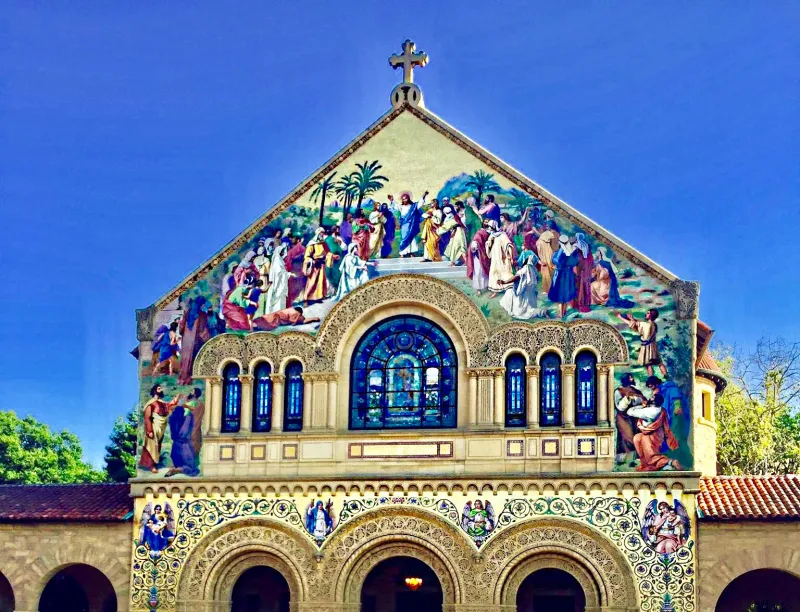At any given day, Stanford’s gorgeous Memorial Church will be surrounded by tourists gaping at the students and happily snapping photos of Stanford’s most beautiful building. It’s oft featured on postcards and promotional material, as quintessentially Stanford as the tree. It’s a little ironic, in fact, given that the student body isn’t outwardly religious.
From its founding, Stanford has committed to be a non-denominational school, meaning that it does not identify with a specific religion (unlike many other major universities). Yet, despite Stanford’s hyper-intellectual scientific vibe, over 70 percent of students identify with a certain religion.
So what gives? Stanford is filled with genius students, often instilled with a healthy dose of skepticism and a heavy interest in the sciences, which can often be a lethal combination with regards to religion. On the other hand, a definite majority of students claim to belong to a specific religion, with varying levels of commitment to their religion.
This tension between education and religion, science and spirituality, can be seen going all the way back to the late nineteenth century with Stanford’s founding, when a certain Dr. Thoburn gave a sermon in 1898 on the “warfare between knowledge and religion.” Indeed, science seemed to be winning – in 1931, a Stanford Daily article bemoaned the “row after row of empty seats” at Sunday morning services at Stanford.
By 1944, in the midst of World War II, students still weren’t turning to religion. You would’ve thought with imminent death hanging over their heads and the threat of German invasion, people might be interested in heading to worship sometime, but apparently the opposite was true. The Stanford chaplain at the time, Dr. Elton Trueblood, claimed the following: “People who try to follow Christian principles often feel alone and are ridiculed.”
In 1949, however, when a Stanford chaplain appeared to criticize nonbelievers, one angry listener wrote a furious letter to The Stanford Daily: “…[R]eligion was not intended to be forced or controversial here at Stanford. Our Chaplain has unfortunately violated both of these understandings.”
Students started turning back to religion in the 1950s, but not in the way that professors wanted, according to a 1951 Stanford Daily article. According to Professor Alexander Miller, “College students should seek established churches when they feel a need for religion… [but] many students are now turning to ‘the mystic religious fringe groups.” I’m not sure what these mystic religious fringe groups are (is he trying to insinuate that Stanford students are joining cults?!), but they sure don’t sound good. And if students weren’t joining cults, then there always the threat of communism hanging over their heads, since apparently communism had even infiltrated religion by 1954 (oh, paranoia, one of the many joys of the McCarthy era).
I’ve always thought of the 1960s as the decade of hippies and free love, but apparently there was a nation-wide resurgence in religion as well. A 1961 article commented on an “increased religious interest” in religion classes at Stanford, and by 1969 people were talking about an “explosion in the objective study of religion unmatched in the history of American education.” On the other hand, in 1969 people were also writing about how LSD was the new religion, so maybe spirituality wasn’t on everyone’s minds after all.
The interest in religion seems to have died down in the 1970s, some readers of The Daily even penning angry letters blaming religion as the source of all prejudice. But by the 1980s, religion had become “sexy” again (literally, according to one columnist), with the Stanford dean of the chapel noting in 1985 a significant revival of interest in religion, having to do with the “same forces that elected Ronald Reagan president.” Basically, America was being hit with a big wop of conservatism.
The only thing interesting about the 1990s à la religion was that apparently there was some band called Bad Religion that the Stanford Daily liked to write articles about. Not really sure what that says about religion (or 90s music).
And now that we’ve arrived at the good old morally-depraved twenty-first century, you can see what’s happening in the present. Interest in religion on campus seems relatively subdued, but that doesn’t mean that there isn’t plenty going on in that category. Given Stanford’s plethora of student groups, perhaps it’s not surprising that it also has a wide assortment of religious groups. There are currently about forty student religious groups on campus, ranging from Buddhist to Christian, Muslim to Jewish, and even a Bahá’í group, which existed way back in 1924.
These groups are all eager and welcoming, always seeking new students. Stanford also has a dean of religious life, Dean Shaw, and an Office of Religious Life, which includes a meditation center and an interfaith center called CIRCLE. It’s mission, according to the ORL homepage, is “to guide, nurture and enhance spiritual, religious and ethical life within the Stanford University community.” Though Stanford has always been a nondenominational school, it has never shied away from providing support to those students who want to pursue and be part of a spiritual and religious community.
Contact Caroline Dunn at cwdunn98 ‘at’ stanford.edu.
